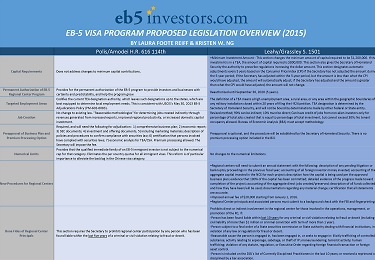 By Laura Foote Reiff and Kristen W. Ng
By Laura Foote Reiff and Kristen W. Ng
The American Entrepreneurship and Investment Act of 2015, H.R. 616, was introduced in the House of Representatives by Congressmen Mark Amodei (R-NV) and Jared Polis (D-CO). H.R. 616 makes the EB-5 program permanent, and introduces a number of much-needed reforms to make the program more efficient, accountable, secure, and effective for all parties involved. Some areas of reform include an improved definition of a Targeted Employment Area, a preapproval process for projects, improved EB-5 petition processing times, and measures to prevent fraud and security violations. In addition, H.R. 616 includes provisions for concurrent filing of the I-526 petition and adjustment of status application if there is a visa number available. The program also provides guidance for children who “age-out.” H.R. 616 also proposes to eliminate derivative family members from the visa quota as well as the per country quota for EB-5 immigrant visas. These reforms aim to alleviate the backlog for Chinese-born investors and provide that the 10,000 visas actually go to the investors themselves.
The American Job Creation and Investment Promotion Reform Act, S. 1501, was introduced in the Senate by Senate Judiciary Committee Chairman Chuck Grassley (R- IA) and Senate Judiciary Committee Ranking Member Patrick Leahy (D-VT). S.1501 seeks to reauthorize the program for five years and proposes a number of integrity reforms for the EB-5 program. This bill focuses on transparency in the government process, securities and anti-fraud measures, and provisions ensuring compliance by regional centers, their principals, and third-party operators. S. 1501 also amends the definition of Targeted Employment Areas, introduces a new method of job count, and raises the minimum capital investment amount. The bill provides detailed guidance on acceptable sources of funds and also includes guidance for children who “age-out.”

DISCLAIMER: The views expressed in this article are solely the views of the author and do not necessarily represent the views of the publisher, its employees. or its affiliates. The information found on this website is intended to be general information; it is not legal or financial advice. Specific legal or financial advice can only be given by a licensed professional with full knowledge of all the facts and circumstances of your particular situation. You should seek consultation with legal, immigration, and financial experts prior to participating in the EB-5 program Posting a question on this website does not create an attorney-client relationship. All questions you post will be available to the public; do not include confidential information in your question.








